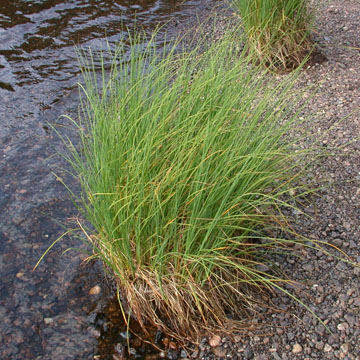

Carex lenticularis - (image 1 of 6)
Taxonomy
Family: Cyperaceae
Section Phacocystis
Habitat
Wet shores of lakes, rivers, ponds, and streams.
Associates
Distribution
Labrador to AK, south to MA, NY, WI, MN, and CA; also in east Asia.
Morphology
Tufted perennial with very short or no rhizomes; culms 8-60 cm; leaf blades 1.5-3.5 mm wide, V-shaped in cross-section, with papillae and stomata on both sides, lacking palisades tissue; spikes 3-6, mostly (1-)1.5-5 cm long and rarely much more than 5 mm thick; terminal spike staminate, less often gynaecandrous or with a few basal perigynia; lateral spikes generally pistillate; pistillate scales red-brown to blackish or dark brown, with a broad pale midstrip, often shorter than the perigynia; perigynia 1.7-3.2 mm, somewhat compressed, lanceolate to ovate or broadly elliptic, 2-ribbed and 3-7-nerved on each face, short-stipitate and with a green or pale brown beak 0.1-0.3 mm long, the body typically greenish distally, papillate on the upper third; achene lenticular, whitish-iridescent.
Notes
Fruiting July to August
Wetland indicator: OBL
Eastern plants are var. lenticularis; several other varieties occur in the west.
References
Ball, P.W. and A.A. Reznicek. 2002. Carex, In: Flora of North America Editorial Committee, Eds. Flora of North America North of Mexico. Volume 23. Oxford University Press, New York.
Gleason, Henry A. and A. Cronquist. 1991. Manual of Vascular Plants of
Northeastern United States and Adjacent Canada. Second Ed.
The New York Botanical Garden. Bronx, NY
|
© Michael Hough 2018 |